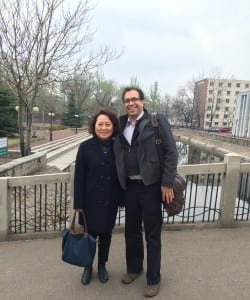Originally published on November 12, 2015
In Stephen Kaplan’s recently released working paper, “Banking Unconditionally: The Political Economy of Chinese Finance in Latin America,” he seeks to examine the extent to which outside investors can influence a nation’s policy making. Professor Kaplan wrote this paper while conducting field research interviews this past year in China and South America for his upcoming book, Neoliberalism in Retreat? The China Boom in Latin America.

While in China, Professor Kaplan presented at a variety of venues and solicited feedback from Chinese scholars at each of his presentations. The paper focuses on the impact of Chinese investment on political influence. After China’s funneling of almost USD $300 billion to developing countries after the 2008 global recession, he became interested in how this impacted debtor countries’ policy room to maneuver. If a nation has strong economic influence in another region, does that translate into political influence? To find the answer, he analyzes the financial relationship between Latin America and China.
Chinese trade has long been highly important in Latin American countries. Some economists and scholars have worried that Latin America could become too dependent on Chinese trade. However, in recent years, China has also become Latin America’s most important banker, lending $100 billion since 2005 and has pledged to invest $250 billion more by 2025. Although much scholarly attention has been paid to Chinese trade, relatively little has been written about Chinese finance, leaving many questions to be answered. How do Chinese lending activities compare to Western approaches? Is China’s emphasis on non-interference in the affairs of the borrower state risky, i.e. will China be able to recoup its investment in a region with a history of debt problems? Does Chinese lending threaten U.S. economic power by financially supporting governments that are skeptical of Western governance?
The Latin American left in particular has often viewed the national budget as central to its ability to provide jobs, higher wages, and social benefits to its constituents – this, of course, requires a government to have a large amount of capital to spend. Dissatisfied and unwilling to participate in austerity-based lending, some Latin American countries have had to look for alternative sources of funding. China’s emergence as a new creditor in Latin American countries has provided the region with a funding source that is independent of global financial markets.
The emergence of China as a creditor in the Latin American region coincided with the 2008 global financial recession. Because of the recession, there was shrinking demand for Chinese goods in the United States. To ensure continued economic growth, China intensified its search for overseas investment. Latin America was the perfect location. Not only did the investment provide new export markets to replace the trade lost from the United States, it also gave China easier access to much-needed raw materials and resources.
At a time when Western financial institutions were reeling from the 2008 financial crisis, Chinese investment also offered Latin American governments a new source of capital. Kaplan notes that there is a key difference between Western and Chinese lenders. Although both are, of course, concerned with debts being repaid, Chinese lenders do not impose onerous policy conditions on the governments of the borrower countries. Chinese lenders still have conditions, such a securing raw materials, or promoting opportunities for Chinese firms and workers. To analyze the differences between the lenders, and to examine Chinese financial investment as a whole, Kaplan considers Brazil and Venezuela, two of China’s largest debtors, before and after investment.

What he finds is surprising – that government budget deficits increase as Chinese state-to-state financing accounts for a larger share of total external public financing. Chinese capital is thus helping underwrite government spending, potentially allowing countries to drift from fiscal responsibility, one of the hallmarks of Western governance. Latin America, which has previously been subject to US hegemony, is now being influenced more and more by China, is an interesting case study in how economic power balances can shift over time.
While governments may gain some policy sovereignty, the verdict is still out on whether this is a positive development for broader economic development. Foreign direct investment by China is marked by success and failure. There are several interesting examples of Chinese investment in Latin America. In 2009, the China Railway Engineering Corporation and the Venezuelan National Railway Authority signed a contract to build the 471.5-km long Tinaco-Anaco railway line. While success is not guaranteed, both countries have made an effort to build factories, with China providing technologies and training to Venezuelan workers. Overall, the railroad will not only provide jobs in Latin America, but spark economic activity along the route. However, not every Chinese investment project holds as much promise. A canal project privately funded by billionaire Wang Jin and costing 40-50 billion dollars almost instantly sparked criticism. Opponents argued that it was unnecessary because of the Panama Canal and would also take land from indigenous communities. Although there is no conclusive evidence that the Chinese government is helping to fund the canal, it has been debated. Professor Kaplan’s work also analyzes Chinese investment into such types of development projects along with other lending activities.

While in Beijing conducting research for his work, Professor Kaplan also presented and participated in the Inter-American Dialogue’s April 2015 China-Latin American Working Group at Peking University that brought together a select group of government officials and experts on China-Latin American relations from both China and the Western Hemisphere. The conference more broadly focused on China’s deepening relationships in Latin America and the Caribbean, including recent diplomatic efforts in the region and prospects for future economic and political relations. Professor Kaplan was on a panel dealing with Chinese and Western perceptions of economic and political sovereign risk in Latin America, participating along with Dr. Zhao Changhui, Chief Country Risk Analyst from the China Eximbank.
In addition to Peking University, Professor Kaplan also presented his latest research at various forums in Beijing, including the Institute for Latin American Studies and the Institute of World Economics and Politics (IWEP) at the Chinese Academy of Social Science (CASS). Professor Kaplan also traveled to Nankai University in the city of Tianjin, China to present his research. His talk there analyzed the differences between Chinese and traditional Western standards of sovereign risk management, and then centered on the policy implications of China’s rapid economic and financial integration in the Western Hemisphere.
